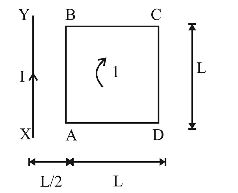Moving Charges and Magnetism
- To convert a galvanometer into an ammeter, one needs to connect a
-
View Hint View Answer Discuss in Forum
To convert a galvanometer into an ammeter, one needs to connect a low resistance in parallel so that maximum current passes through the shunt wire and ammeter remains protected.
Correct Option: A
To convert a galvanometer into an ammeter, one needs to connect a low resistance in parallel so that maximum current passes through the shunt wire and ammeter remains protected.
- A 250-turn rectangular coil of length 2.1 cm and width 1.25 cm carries a current of 85 µA and subjected to magnetic field of strength 0.85 T. Work done for rotating the coil by 180º against the torque is
-
View Hint View Answer Discuss in Forum
Work done, W = MB(cosθ1 – cosθ2)
When it is rotated by angle 180° then W = MB (cos0° – cos 180°) = MB (1 + 1)
W = 2MB
W = 2 (NIA) B
= 2 × 250 × 85 × 10–6[1.25 × 2.1 × 10–4] × 85 × 10–2 = 9.1 µJCorrect Option: D
Work done, W = MB(cosθ1 – cosθ2)
When it is rotated by angle 180° then W = MB (cos0° – cos 180°) = MB (1 + 1)
W = 2MB
W = 2 (NIA) B
= 2 × 250 × 85 × 10–6[1.25 × 2.1 × 10–4] × 85 × 10–2 = 9.1 µJ
- An arrangement of three parallel straight wires placed perpendicular to plane of paper carrying same current 'I' along the same direction is shown in fig. Magnitude of force per unit length on the middle wire 'B' is given by

-
View Hint View Answer Discuss in Forum
Force per unit length between two parallel current carrying conductors,
F = μ0i1i2 2πd
Since same current flowing through both the wires
ii = i2 = i
so F1 = μ0i2 = F2 2πd 
∴ Magnitude of force per unit length on the middle wire ‘B’ Fnet = √F1²
+ F2² =μ0i2 √2πd Correct Option: C
Force per unit length between two parallel current carrying conductors,
F = μ0i1i2 2πd
Since same current flowing through both the wires
ii = i2 = i
so F1 = μ0i2 = F2 2πd 
∴ Magnitude of force per unit length on the middle wire ‘B’ Fnet = √F1²
+ F2² =μ0i2 √2πd
- A square loop ABCD carrying a current i, is placed near and coplanar with a long straight conductor XY carrying a current I, the net force on the loop will be :

-
View Hint View Answer Discuss in Forum
The direction of current in conductor

XY and AB is same
∴ FAB = iℓB (attractive)FAB = i(L). μ0I (←) μ0iI (←) 2π 
L 
π 2
FBC opposite to FAD
FBC (↑) and FAD (↓)
⇒ cancels each other
FCD = iℓB (repulsive)FCD = i(L). μ0I (→) = μ0iI (→) 2π 
3L 
3π 2
Therefore the net force on the loop
Fnet = FAB + FBC + FCD + FAD
Fnet = μ0iI - μ0iI = 2μ0iI π 3π 3π Correct Option: A
The direction of current in conductor

XY and AB is same
∴ FAB = iℓB (attractive)FAB = i(L). μ0I (←) μ0iI (←) 2π 
L 
π 2
FBC opposite to FAD
FBC (↑) and FAD (↓)
⇒ cancels each other
FCD = iℓB (repulsive)FCD = i(L). μ0I (→) = μ0iI (→) 2π 
3L 
3π 2
Therefore the net force on the loop
Fnet = FAB + FBC + FCD + FAD
Fnet = μ0iI - μ0iI = 2μ0iI π 3π 3π
- A rectangular coil of length 0.12 m and width 0.1 m having 50 turns of wire is suspended vertically in a uniform magnetic field of strength 0.2 weber/m². The coil carries a current of 2A. If the plane of the coil is inclined at an angle of 30° with the direction of the field, the torque required to keep the coil in stable equilibrium will be :
-
View Hint View Answer Discuss in Forum
Here, number of turns of coil, N = 50
Current through the coil I = 2A
Area A = l × b = 0.12 × 0.1m²
Magnetic field →B = 0.2 ω/m²
Torque required to keep the coil in stable equilibrium.
τ = →M × →B sin 60° = Ni AB sin 60°
= 50 × 2 × 0.12 × 0.1 × 0.2 × √3/2
= 12√3 × 10-2 = 0.20784 NmCorrect Option: A
Here, number of turns of coil, N = 50
Current through the coil I = 2A
Area A = l × b = 0.12 × 0.1m²
Magnetic field →B = 0.2 ω/m²
Torque required to keep the coil in stable equilibrium.
τ = →M × →B sin 60° = Ni AB sin 60°
= 50 × 2 × 0.12 × 0.1 × 0.2 × √3/2
= 12√3 × 10-2 = 0.20784 Nm

